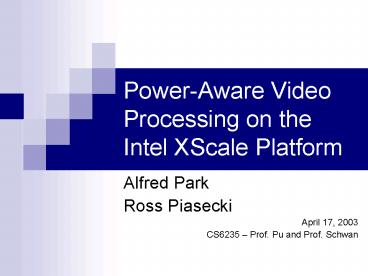PowerAware Video Processing on the Intel XScale Platform PowerPoint PPT Presentation
1 / 34
Title: PowerAware Video Processing on the Intel XScale Platform
1
Power-Aware Video Processing on the Intel XScale
Platform
- Alfred Park
- Ross Piasecki
- April 17, 2003
- CS6235 Prof. Pu and Prof. Schwan
2
Agenda
- Motivation
- Objectives
- Background Information
- Previous Work
- Intel XScale Architecture
- Power Algorithms
- Experimental Parameters
- Assumptions
- Results
- Conclusions
- Future Work
- Questions
3
Motivation
- Availability of new Dynamic Voltage Scaling (DVS)
technologies (variable voltage) in power-aware
processors - Power utilization involves both frequency and
voltage scaling - Slack period with respect to QoS
- Importance of power conservation in mobile
devices
4
Objectives
- Implement DVS and Dynamic Frequency Scaling (DFS)
algorithms using real-time handlers - Show that power efficiency using both DVS and DFS
outperforms DFS alone - Show that usage of a DVS/DFS algorithm does not
compromise real-time deadlines - Real-Time handlers implemented via KEcho
5
Revised Objectives
- Due to issues beyond our control (i.e. hardware
availability and KEcho incompatibilities) we were
forced to revise our objectives - Original objectives without DVS support
- Although XScale supports DVS changes on-the-fly,
voltage scaling support is accomplished using 3rd
party off-board hardware - No kernel-level real-time handlers due to KEcho
issues
6
Background
- Power Equations
- Power C x F x V2
- Power I x V
- For processors, reduction in power is
accomplished through a reduction in frequency,
which can be accompanied by a reduction in
voltage - Reducing clock rate (F) of a processor will
reduce power consumption linearly - A quadratic reduction in power can be attained by
reducing voltage (V) - Hypothesis combining clock rate and voltage
reductions will net large power efficiency gains!
7
Background (Cont.)
- DVS and DFS in the context of video decoding
- Frame rate deadlines
- Slack periods
- Jitter
8
Previous Work
- Our experiments will be heavily based on the work
presented in Poellabauer and Schwan 2002, which
describes DFS algorithms on the iPAQ StrongArm
PDAs - Various papers and conference proceedings have
been published on portable and low-power devices
utilizing DVS/DFS algorithms - The XScale platform is a new platform with very
little related previous work
9
Intel XScale Architecture
- Designed from the ground up to be power-aware and
high performance - Utilizes the ARM instruction set for instruction
compatibility with previous ARM processors
(StrongARM SA-1110) - Advanced power features
- Variable voltage (can be reduced to as low as
0.95v) - Frequency scaling in software (on-the-fly)
- Low power modes
10
ADI/BRH Platform
- Based on the Intel 80200EVB evaluation board with
larger memory bandwidth - Contains the Intel XScale 80200 processor core
- Core clock rates from 400MHz to 733MHz in 66MHz
increments - Running a modified Linux 2.4.19 kernel
11
ADI/BRH Board
12
Power Algorithm
- Modes of Operation
- Aggressive
- Conservative
- Frequency Cycling
- Minimize jitter (i.e. real deadlines, FPS)
- Interrupts are generated every 250ms
- Fourth interrupt call checks the real deadlines
- Slack Buffers
- Pixel buffer (generic bit-bucket storing future
frame data)
13
Power Algorithm (Cont.)
14
Experimental Parameters
- Frame Rate Deadline
- Width x Height x Frames Per Second
- e.g. 320 x 240 x 15 1.152 Mpixels/sec
- Images
- 18 PPM Files at 24-bit depth each
- Image Manipulation
- Real-Time Image Reduction
- Test effectiveness of aggressive, conservative,
and cycling models
15
Assumptions
- Video stream is emulated through a sequence of
images - Arbitrarily large pixel buffer
- Source data stream is faster than the data
consumption rate - The video stream is random enough not to be
cached
16
Experimental Results
- Clock rate changes
- Slack and real deadline misses
- Slack (pixel buffer) sizes
- Throughput (pixels/sec)
- Pixels processed per frequency setting
- Power
17
(No Transcript)
18
(No Transcript)
19
(No Transcript)
20
(No Transcript)
21
(No Transcript)
22
(No Transcript)
23
(No Transcript)
24
(No Transcript)
25
(No Transcript)
26
Empirical Data
27
(No Transcript)
28
Possible DVSDFS Results
- With conservative estimates
29
Demo
- Baseline readings
- Videos
30
Oscilloscope Baseline Current
400MHz Reading
733MHz Reading
31
Demo Videos
32
Conclusions
- The conservative timing model does not
necessarily improve deadline miss ratios - Although the aggressive mode induces more
frequency change sequences, the frequent lower
clock rates pay off with respect to power
consumption - A DVS algorithm can add significant power savings
without affecting the frame rate
33
Future Work
- Implementing a DVS algorithm
- Potential issues
- Development of alternate power algorithms
- Improving the aggressive timing model
- Potential integration with an actual movie player
- Moving the image reduction algorithm to a kernel
for cooperation with kernel-level real-time
handlers (KEcho) - Port power/image algorithms to the Intel PXA 250
PCA processor - Potential problems
34
- Questions???

